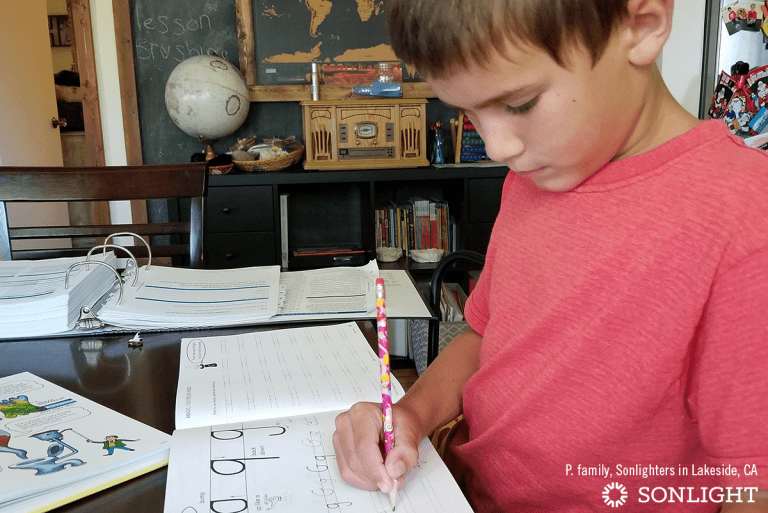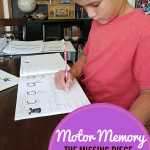When teaching kids manuscript and cursive handwriting, many homeschool parents forget about the importance of motor memory. Motor memory, simply put, is the ability to instantly recall and replicate specific motor movements. When you do something so many times that it becomes automatic, motor memory is at play.

Tasks that use motor memory seem complex at first, but eventually we are able to do them without even thinking. Some examples include tying shoes, walking, balancing on one leg, kicking a ball, biking, and driving. When we first learn to cycle, it feels awkward and uncomfortable, but within a fairly short time period, a child is able to perform the needed movements of pedaling and balancing without consciously thinking about them. This memory is stored for years, even if we don't regularly bike, and when we try to ride again years later, this memory is easily accessed. Thanks to motor memory, we can still ride a bike!
To illustrate how motor memory works, think of opening a door. Every time you enter and exit a door, do you stop to think about how to open it and move through the door frame? Of course not. You rely on motor memory to navigate a door. But now imagine you are on crutches or are carrying a heavy load. Now your motor memory fails you, and you have to pause to consciously consider how to manage the door.
How Motor Memory Affects Handwriting
For those of us who have mastered handwriting, we write without stopping to think of each step. We don’t need to remember how each letter is formed or where to start and end with our pen. We just put pen to paper and write what we are thinking about. It feels absolutely automatic for us!
In contrast, children who struggle with handwriting have not yet acquired the motor memory that makes writing automatic.
Prerequisites of Motor Memory
Before you begin working on motor memory, make sure your child is doing well in the following areas:
- identifying letters by sight
- recognizing that reading and writing go from left to right
- understanding the sequence in which each letter is formed
- knowing correct posture, pencil grasp, and paper position
- transcribing entire words at a time, whether through copywork, dictation, or other means
- understanding spacing between words and letters
Less Writing, More Handwriting
The best way to get good at handwriting is to do it so often that you don’t have to think about it. Therefore daily handwriting practice is essential. This practice needs to be focused on handwriting skills, not sheer volume of writing.
It is better to write less with great handwriting than it is to write more with poor handwriting. Ten well-written words will do far more to improve handwriting skills than a ten-page paper of poor handwriting will. Assign enough handwriting to encourage motor memory, but not so much that your child slides into sloppy handwriting. This threshold will be different for each student.
∞ Infinity Symbols ∞
One good way to ingrain the motions needed for most letters is to have your child draw and keep tracing over infinity symbols (∞). As long as one keeps going around an infinity symbol, it is never ending, making it a perfect handwriting skill builder.
Take a sheet of paper and turn it so it is the long way across, giving you the most space for writing. Draw a very large infinity symbol on it, taking up most of the page but leaving a little bit of a blank border around the end in case a pencil or crayon slips off the line and into that area.
Now simply arm your child with a variety of writing implements and allow them to write. The entire assignment is to keep going around and around the infinity circle with few to no stops. It can be a dozen times or a hundred times. They can start at any point on the symbol and stop at any point.
Do this exercise daily until they are very good at making infinity symbols without thinking about it (tapping into motor memory). You can use this on its own or with daily handwriting practice.
Taking Infinity to the Next Level
Once your child is good at making infinity symbols and has had at least several days of practice, try having them draw a straight line down the middle of the page dividing the infinity symbol in half, and use that line to help them make lowercase letters over top of their symbols.
Most of the letters of the alphabet can be made within this infinity shape with a line down the middle. For example, a can be made using the circle on the left, and going to the straight line, in one smooth motion. The letter b can be made by starting in the middle and then following the right hand circle around. C can be found on the left again, and so forth.
A few letters (x, z, w, etc) don’t fit well into this, but with a little creativity, you can adapt most letters to fit in well.
Focusing on the Movement
Sometimes children use the visual aspect of writing to help them learn, but still struggle to make it fully motor dependent, that is to rely on motor memory. One easy way to boost motor memory is to try handwriting activities while blindfolded. Removing the aid of sight helps to isolate the motion of each letter, rather than its appearance, and uses different portions of the brain.
Infinity In Between
If a child appears to need even more practice, or is less than fully fluid with their movements when making letters, but seems to have mastered the infinity symbol, you can have them practice small infinity circles between each word or letter. This will help them associate the movements needed for making the infinity symbol with the movements needed for handwriting.
Using a Handwriting Program…Or Not
One question I get asked frequently is whether there is a real benefit to using a handwriting program. My answer is yes. Handwriting is, as I described above, a motor memory skill, and to write well, one must practice writing well. Handwriting books are designed to encourage children to always write the correct way, making sure their practice builds accurate motor memory.
If your child is struggling with handwriting, they will benefit greatly from a formal handwriting program much more than they will from homemade handwriting pages, free printables, or books from the dollar store. Require them to do their best and follow the instructions outlined in the curriculum.
Not all children need handwriting books. Some have naturally neat handwriting and seem to intuitively write without much effort at all. But many children benefit from having a curriculum that clearly shows the process and allows them to practice from samples that are already correctly written.
Hopefully, in a short time period, your children will be able to master handwriting and do well with it. But, as always, the most important component to learning handwriting is practice, practice, practice, always using good handwriting. The rest comes with time.
Sonlight carries more than one handwriting program. See your options here.







